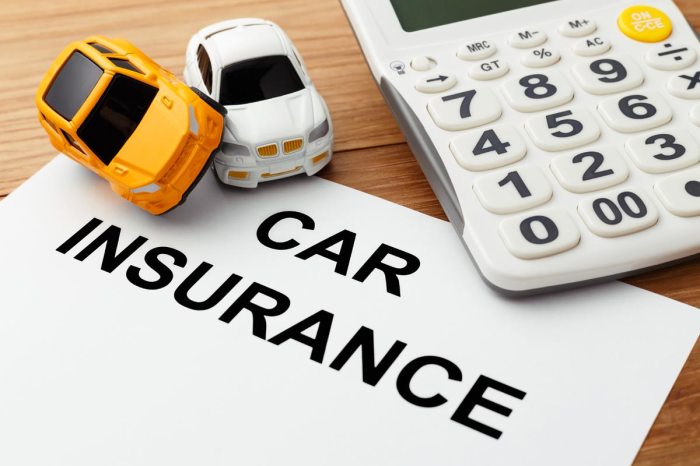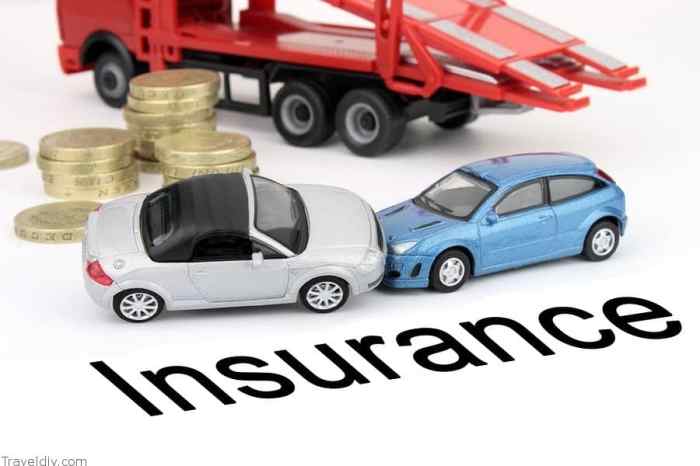Securing the right auto insurance for your car is a crucial step in responsible vehicle ownership. Beyond the legal requirements, understanding the various coverage options and factors influencing premiums empowers you to make informed decisions that protect both your financial well-being and your peace of mind. This guide delves into the complexities of auto insurance, providing a clear and concise overview to help you navigate this essential aspect of car ownership.
From understanding the nuances of liability, collision, and comprehensive coverage to effectively comparing quotes and filing claims, we aim to equip you with the knowledge needed to find the best auto insurance for your specific needs and budget. We’ll explore the various factors that impact your premium, offering practical strategies to potentially lower your costs and ensure you’re adequately protected on the road.
Factors Affecting Auto Insurance Premiums
Understanding the factors that influence your auto insurance premiums is crucial for managing your budget and securing the best possible coverage. Insurance companies utilize a complex algorithm considering various aspects of your profile and driving habits to assess your risk and determine your premium. This process isn’t arbitrary; it’s designed to reflect the likelihood of you filing a claim.
Driving Record
Your driving history significantly impacts your insurance premium. A clean record with no accidents or traffic violations will generally result in lower premiums. Conversely, accidents, especially those deemed your fault, and traffic violations like speeding tickets or DUIs, will substantially increase your premiums. The severity of the incident also matters; a minor fender bender will have less impact than a serious accident causing significant damage or injury. Insurance companies maintain detailed records of your driving history, often accessed through state-level databases. Multiple violations within a short period can lead to significantly higher premiums or even policy cancellation.
Age
Age is a strong predictor of driving risk. Younger drivers, particularly those under 25, are statistically more likely to be involved in accidents due to inexperience and risk-taking behavior. Therefore, they generally pay higher premiums. As drivers age and gain experience, their premiums typically decrease, reaching their lowest point in the middle-aged years. However, premiums may rise again in later years due to potential health concerns affecting driving abilities.
Location
Where you live significantly affects your insurance rate. Insurance companies consider the crime rate, the frequency of accidents in your area, and the average cost of vehicle repairs. Areas with high accident rates or a high incidence of vehicle theft will generally have higher insurance premiums due to the increased risk of claims. Rural areas often have lower premiums than densely populated urban areas.
Vehicle Type
The type of vehicle you drive also influences your insurance costs. Sports cars and luxury vehicles are often more expensive to insure due to their higher repair costs and the greater likelihood of theft. The vehicle’s safety features also play a role; cars with advanced safety technology may qualify for discounts. The age and make of your vehicle are also considered; older cars may be cheaper to insure but may lack modern safety features.
Credit Score
In many states, your credit score is a factor in determining your auto insurance premium. Studies have shown a correlation between credit score and insurance claims; individuals with lower credit scores tend to file more claims. This is not necessarily a reflection of driving ability but rather a broader assessment of risk. However, the use of credit scores in insurance is a controversial practice and is not permitted in all states.
- Maintain a clean driving record: Avoid speeding tickets and accidents.
- Consider a vehicle with safety features: Modern safety features can reduce premiums.
- Shop around for insurance: Compare quotes from multiple insurers.
- Bundle your insurance: Combining auto and home insurance can often result in discounts.
- Increase your deductible: A higher deductible means lower premiums, but you pay more out-of-pocket in case of a claim.
- Maintain a good credit score: A good credit score can lead to lower premiums in states where it is a rating factor.
- Take a defensive driving course: Completing a defensive driving course may qualify you for discounts.
Finding the Best Auto Insurance Rates
Securing the most affordable auto insurance requires a proactive and informed approach. By understanding the process of comparing quotes, negotiating rates, and effectively shopping online, you can significantly reduce your annual premiums. This section details the strategies involved in achieving the best possible rates for your car insurance.
Comparing Insurance Quotes
Obtaining multiple quotes from different insurance providers is crucial for finding the best rate. This allows for a direct comparison of coverage options and prices, enabling you to identify the most cost-effective policy that meets your needs. Begin by gathering quotes from at least three to five different insurers. Consider a mix of large national companies and smaller regional providers, as their pricing structures can vary significantly. Be sure to provide consistent information across all applications to ensure an accurate comparison. This includes details such as your driving history, vehicle information, and coverage preferences. Comparing quotes apples-to-apples ensures a fair evaluation of different providers.
Negotiating Lower Rates
Once you have several quotes, you can leverage this information to negotiate lower rates. Contact the insurance companies offering rates you find competitive and explain that you’ve received lower quotes from other providers. Many insurers are willing to adjust their premiums to retain your business. Highlight any positive aspects of your driving record, such as a clean history or completion of a defensive driving course. Consider bundling your auto insurance with other policies, such as homeowners or renters insurance, for potential discounts. Be polite but firm in your negotiations, and don’t be afraid to walk away if a better offer isn’t presented. Remember to document all communications and agreements reached during negotiations.
Effective Online Car Insurance Shopping
Shopping for car insurance online offers several advantages, including convenience and access to a wide range of providers. Start by using comparison websites that allow you to input your information once and receive quotes from multiple insurers simultaneously. These websites often provide a clear and concise comparison of coverage options and prices. Carefully review the details of each quote, paying close attention to coverage limits, deductibles, and any additional fees. Check online reviews and ratings of different insurers to assess their customer service and claims handling processes. Ensure that the insurer is licensed and reputable in your state before purchasing a policy. Once you’ve identified a suitable policy, complete the online application process carefully and accurately. Confirm your coverage details and payment arrangements before finalizing the purchase.
Understanding Insurance Policies

Navigating the world of auto insurance policies can feel overwhelming, but understanding the key terms and conditions is crucial for securing adequate coverage. This section will clarify common policy elements and highlight potential areas of ambiguity to help you become a more informed consumer.
Standard auto insurance policies typically include several key components. These components define the coverage provided, the limits of liability, and the responsibilities of both the insurer and the insured. Failing to understand these components can lead to significant financial hardship in the event of an accident or claim.
Policy Declarations
The declarations page is the summary of your policy. It contains your personal information, the covered vehicle’s details (make, model, VIN), the policy period, the coverage types you selected (liability, collision, comprehensive, etc.), and the premium amount. This page is the most important single page of your policy, providing a snapshot of your coverage at a glance. Carefully review this section to ensure all the information is accurate and reflects the coverage you intended to purchase.
Coverage Sections
This section Artikels the specifics of each type of coverage you purchased. Liability coverage protects you financially if you cause an accident that injures someone or damages their property. Collision coverage pays for repairs to your vehicle regardless of fault. Comprehensive coverage covers damage to your vehicle from events other than collisions, such as theft, vandalism, or weather-related incidents. Uninsured/Underinsured Motorist coverage protects you if you are involved in an accident with a driver who lacks sufficient insurance. Each coverage type will have its own limits and exclusions, which should be carefully examined.
Exclusions and Limitations
Every insurance policy contains exclusions—specific events or circumstances that are not covered. Common exclusions might include damage caused by wear and tear, intentional acts, or driving under the influence of alcohol or drugs. Limitations define the maximum amount the insurer will pay for a particular claim. Understanding these limitations is critical to avoid unpleasant surprises when filing a claim. For example, a policy might have a specific deductible for collision coverage, meaning you are responsible for paying a certain amount before the insurance company starts paying.
Conditions
This section Artikels the responsibilities of both the insured and the insurer. It may include requirements for reporting accidents, cooperating with investigations, and maintaining the vehicle in a safe condition. Breaching these conditions could affect your claim’s validity. For instance, failing to report an accident promptly could jeopardize your coverage.
Ambiguity in Insurance Contracts
Insurance contracts can be complex and contain legal jargon that can be difficult to understand. Terms like “proximate cause,” “actual cash value,” and “subrogation” might be unclear to the average person. Furthermore, the broad wording of some clauses can lead to disputes over coverage. It’s crucial to ask your insurer for clarification on any terms or conditions you don’t understand.
Crucial Clauses to Look For
Always carefully review your policy’s declarations page, ensuring all information is correct. Pay close attention to the limits of liability for bodily injury and property damage in your liability coverage. Scrutinize the exclusions and limitations for each coverage type, noting any specific circumstances that might not be covered. Finally, understand the conditions you must meet to maintain your coverage and ensure your claims are processed fairly.
Auto Insurance for Specific Situations

Auto insurance needs vary significantly depending on individual circumstances. Understanding these nuances is crucial to securing the right coverage at the best possible price. Factors like age, driving history, vehicle type, and driving habits all play a significant role in determining your insurance premiums and the type of policy best suited for your needs.
Auto Insurance for New Drivers
New drivers typically face higher insurance premiums due to their lack of driving experience. Insurance companies consider them higher risk. Insurers often assess premiums based on a combination of factors, including age, driving record (even if it’s short), and the type of vehicle driven. Many insurers offer discounts for completing driver’s education courses or maintaining good grades in school. Some may also offer discounts for adding a more experienced driver to the policy as a secondary driver. For example, a new driver aged 16 driving a powerful sports car will likely pay substantially more than a new driver aged 20 driving a smaller, fuel-efficient vehicle.
Auto Insurance for Senior Drivers
While senior drivers generally have more experience, their physical abilities might decline with age, potentially leading to increased accident risk. Insurance companies often consider age a factor in premium calculations. However, many insurers also offer discounts for senior drivers who complete defensive driving courses or maintain accident-free driving records. For example, a 70-year-old driver with a spotless record might receive a senior driver discount, potentially offsetting higher premiums associated with age.
Auto Insurance for High-Risk Drivers
Drivers with poor driving records, multiple accidents, or DUI convictions are considered high-risk. These drivers typically face significantly higher insurance premiums. The severity of past incidents directly impacts premium costs. For instance, a driver with a history of speeding tickets and at-fault accidents will likely pay considerably more than a driver with a clean record. Some insurers specialize in insuring high-risk drivers, although their rates might be considerably higher than those offered by mainstream companies.
Auto Insurance for Classic Cars
Classic car insurance differs from standard auto insurance. It typically focuses on the car’s value as a collectible rather than just its functionality as transportation. Policies often include agreed-value coverage, meaning the insurer agrees to pay a predetermined amount in case of a total loss, regardless of the car’s current market value. Comprehensive coverage is generally recommended to protect against theft, vandalism, and other potential damages. For example, a 1967 Mustang valued at $50,000 would require a specialized policy reflecting its higher value.
Auto Insurance for Motorcycles
Motorcycle insurance is distinct from car insurance due to the inherent risks associated with motorcycle riding. Premiums are often higher than car insurance because motorcycles offer less protection in accidents. Coverage options may include liability, collision, comprehensive, and uninsured/underinsured motorist protection. Factors like motorcycle type, engine size, and rider experience influence premium calculations. For example, a high-powered sportbike will typically have higher insurance premiums than a smaller, less powerful cruiser.
Auto Insurance for Commercial Vehicles
Commercial vehicle insurance covers vehicles used for business purposes, such as delivery trucks, vans, or taxis. These policies differ from personal auto insurance and usually have higher premiums due to increased risk and usage. The type of business, vehicle usage, and driver history all affect premium costs. Coverage often includes liability protection for accidents involving the commercial vehicle and cargo insurance. For instance, a trucking company hauling hazardous materials will require significantly more comprehensive coverage than a small business using a van for local deliveries.
Auto Insurance for High-Mileage vs. Low-Mileage Drivers
Drivers who travel significantly more miles annually generally pay higher insurance premiums than those who drive less. This is because increased mileage correlates with a greater likelihood of accidents. Many insurers offer discounts for low-mileage drivers who demonstrate limited annual driving. For example, a driver who commutes by public transport and only drives a few thousand miles a year may qualify for a low-mileage discount, while a salesperson covering a large territory would expect to pay more due to higher mileage.
Final Thoughts

Choosing the right auto insurance for your car involves careful consideration of your individual needs and risk profile. By understanding the different types of coverage, factors affecting premiums, and the claims process, you can make informed decisions to secure the best possible protection. Remember to regularly review your policy and compare rates to ensure you maintain optimal coverage at a competitive price. Proactive planning and a thorough understanding of your policy are key to navigating the complexities of auto insurance with confidence.
FAQ Overview
What is the difference between liability and collision coverage?
Liability coverage protects others if you cause an accident, paying for their injuries and property damage. Collision coverage pays for repairs to your vehicle regardless of fault.
How does my credit score affect my auto insurance premiums?
In many states, insurers use credit-based insurance scores to assess risk. A higher credit score often translates to lower premiums.
What should I do immediately after a car accident?
Ensure everyone is safe. Call emergency services if needed. Exchange information with the other driver(s), take photos of the damage, and contact your insurance company.
Can I get auto insurance if I have a poor driving record?
Yes, but you may pay higher premiums. Consider working with a specialist insurer or taking defensive driving courses to improve your standing.
What is uninsured/underinsured motorist coverage?
This coverage protects you if you’re injured in an accident caused by an uninsured or underinsured driver.